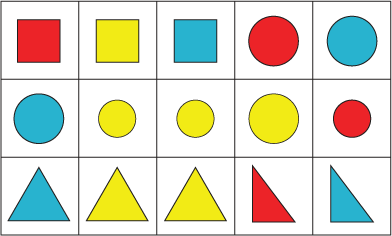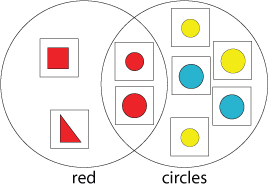Or search by topic
Number and algebra
Geometry and measure
Probability and statistics
Working mathematically
Advanced mathematics
For younger learners
Data Shapes



- Problem
- Getting Started
- Student Solutions
- Teachers' Resources
Data Shapes
Sara and Will were sorting some pictures of shapes on cards.

"I'll collect the circles," said Sara, "there are lots of those."
"I'll take the red ones," answered Will, "I like red."
Can you see any cards they would both want?
Here is a picture of all the cards they had.

How many cards could they have had each?
How many ways can you find to sort the cards?
Can you see any cards that are the same as other cards?
If you would like to make your own cards like these they can be downloaded here and cut into fifteen separate cards.
Why do this problem?
Possible approach

Key questions
What can you see?
Possible extension
Learners could try one of the harder sorting problems, for example, Butterfly Cards.
Possible support
Some children may need a suggestion from you as to how to sort the cards to get them started.
You may also like
Triangle Animals
How many different ways can you find to join three equilateral triangles together? Can you convince us that you have found them all?
Triple Cubes
This challenge involves eight three-cube models made from interlocking cubes. Investigate different ways of putting the models together then compare your constructions.
The Add and Take-away Path
Two children made up a game as they walked along the garden paths. Can you find out their scores? Can you find some paths of your own?

